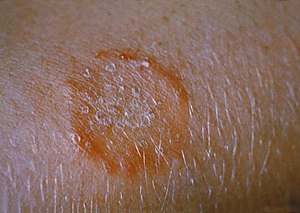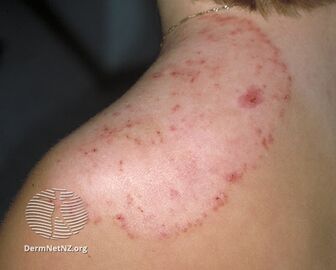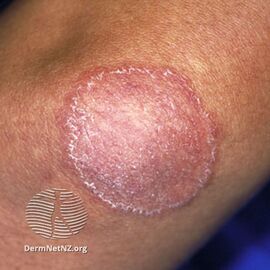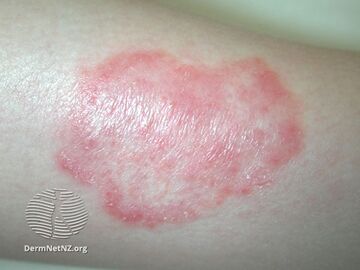Tinea corporis
| Tinea corporis | |
|---|---|
| Other names: Ringworm,[1] tinea circinata,[2] tinea glabrosa[1] | |
 | |
| This patient presented with ringworm on the arm, or tinea corporis due to Trichophyton mentagrophytes. | |
| Specialty | Dermatology |
| Symptoms | Circular, slightly reddish patch on arms, legs or trunk[2] |
| Causes | Dermatophytes, most common genera: Trichophyton, Microsporum, and Epidermophyton |
| Diagnostic method | Appearance, microscopy[2] |
| Treatment | Antifungals[2] |
| Frequency | 20% lifetime risk[3] |
Tinea corporis, also known as ringworm, is a type of fungal infection of the skin of the arms, legs, and front and back of the chest.[1][3] It typically presents as a well defined slightly reddish, scaly, circular patch with an edge that appears to be raised and expanding.[2] The centre often looks paler.[2]
It is caused by a dermatophyte.[4] Diagnosis is generally based on the appearance and symptoms. It may be confirmed by either culturing or looking at a skin scraping under a microscope.[3] It is a type of dermatophytosis.[3]
Treatment is usually by applying an antifungal cream. Sometimes, an antifungal drug is required by mouth.[3]
Tinea corporis is common.[3] Up to 1 in 5 people will be infected in there lifetime.[3] Males and females are affected equally frequently.[3]
Signs and symptoms
Generally, Tinea corporis appears as enlarging flaky raised red rings with a central area of clearing.[3][5] It may look oval.[3] Other features of tinea corporis include itching, with loss of hair over the patch and dry and flaky surrounding skin.[6] Similar appearances of ringworm may also occur on the scalp (tinea capitis), beard area (tinea barbae) or the groin (tinea cruris.[3]
-
Tinea corporis
-
Tinea corporis
-
Tinea corporis
-
Tinea Corporis, right buttock
Causes
Tinea corporis is caused by a tiny fungus known as dermatophytes, usually of the genera Trichophyton (skin, hair, and nails), Microsporum (skin and hair), and Epidermophyton (skin and nails).[3] T. rubrum, T. tonsurans, and M. canis are the most common causes.[3] These fungi normally live on the skin surface, and when the opportunity is right, they can induce a rash or infection.[4] The causative fungi can vary according to which part of the world a person lives in.[3] T. interdigitale, T. verrucosum, T. violaceum, T. concentricum, E. floccosum, M. audouinii, and M. gypseum, can also cause Tinea corporis. Other more rare fungi can also cause the condition.[3]
It can spread from one person to another via direct skin contact.[5] People can acquire Tinea corporis from animals, such as after touching dogs and cats.[5] The condition can occur following contact with other animals such as horses, pigs, ferrets and cows.[5] It can occur by touching non-living objects like personal care products, bed linen, combs, athletic gear, or hair brushes.[5]
People at higher risk of getting Tinea corporis include those who live in crowded humid conditions, sweat excessively, participate in close contact sports like soccer, rugby, or wrestling, those who wear tight clothing or who have a weakened immune system such as HIV or are taking drugs that prevent fighting infection.[citation needed]
Diagnosis
Superficial scrapes of skin examined underneath a microscope may reveal the presence of a fungus. This is done by utilizing a diagnostic method called KOH test,[7] wherein the skin scrapings are placed on a slide and immersed on a dropful of potassium hydroxide solution to dissolve the keratin on the skin scrappings thus leaving fungal elements such as hyphae, septate or yeast cells viewable. If the skin scrapings are negative and a fungus is still suspected, the scrapings are sent for culture. Because the fungus grows slowly, the culture results do take several days to become positive.[8]
Prevention
Because fungi prefer warm, moist environments, preventing ringworm involves keeping skin dry and avoiding contact with infectious material. Basic prevention measures include:
- Washing hands after handling animals, soil, and plants.
- Avoiding touching characteristic lesions on other people.
- Wearing loose-fitting clothing.
- Practicing good hygiene when participating in sports that involve physical contact with other people.[4]
Treatment
Most cases are treated by application of topical antifungal creams to the skin, but in extensive or difficult to treat cases, systemic treatment with oral medication may be required. The over-the-counter options include tolnaftate, as well as ketoconazole (available as Nizoral shampoo that can be applied topically).
Among the available prescription drugs, the evidence is best for terbinafine and naftifine, but other agents may also work.[9]
Topical antifungals are applied to the lesion twice a day for at least 3 weeks. The lesion usually resolves within 2 weeks, but therapy should be continued for another week to ensure the fungus is completely eradicated. If there are several ringworm lesions, the lesions are extensive, complications such as secondary infection exist, or the patient is immunocompromised, oral antifungal medications can be used. Oral medications are taken once a day for 7 days and result in higher clinical cure rates. The antifungal medications most commonly used are itraconazole, terbinafine, and ketoconazole.[4][10]
The benefits of the use of topical steroids in addition to an antifungal is unclear.[9] There might be a greater cure rate but no guidelines currently recommend its addition.[9] The effect of Whitfield's ointment is also unclear.[9]
Outcomes
Tinea corporis is moderately contagious and can affect both humans and pets. If a person acquires it, the proper measures must be taken to prevent it from spreading. Young children in particular should be educated about the infection and preventive measures: avoid skin to skin contact with infected persons and animals, wear clothing that allows the skin to breathe, and don't share towels, clothing or combs with others. If pets are kept in the household or premises, the animal should be checked for tinea,[11] especially if hair loss in patches is noticed or the pet is scratching excessively. The majority of people who have acquired tinea know how uncomfortable the infection can be. However, the fungus can easily be treated and prevented in individuals with a healthy immune system.[6][10]
Epidemiology
Tinea corporis is the commonest dermatophytosis and occurs across the world, particularly hot, humid places. Young adults are most prone, and males and females are affected equally. Up to 1 in 5 people will be infected in there lifetime.[3]
Society and culture
When the dermatophytic infection presents in wrestlers, with skin lesions typically found on the head, neck, and arms it is sometimes called tinea corporis gladiatorum.[12][13]
See also
References
- ↑ 1.0 1.1 1.2 Bolognia, Jean; Jorizzo, Joseph L.; Rapini, Ronald P. (2007). Dermatology (2nd ed.). St. Louis, Mo.: Mosby Elsevier. p. 1135. ISBN 978-1-4160-2999-1. OCLC 212399895.
- ↑ 2.0 2.1 2.2 2.3 2.4 2.5 James, William D.; Elston, Dirk; Treat, James R.; Rosenbach, Misha A.; Neuhaus, Isaac (2020). "15. Diseases resulting from fungi and yeasts". Andrews' Diseases of the Skin: Clinical Dermatology (13th ed.). Elsevier. p. 295. ISBN 978-0-323-54753-6. Archived from the original on 2023-04-19. Retrieved 2023-04-19.
- ↑ 3.00 3.01 3.02 3.03 3.04 3.05 3.06 3.07 3.08 3.09 3.10 3.11 3.12 3.13 3.14 3.15 Leung, Alexander KC; Lam, Joseph M; Leong, Kin Fon; Hon, Kam Lun (20 July 2020). "Tinea corporis: an updated review". Drugs in Context. 9. doi:10.7573/dic.2020-5-6. ISSN 1745-1981. PMID 32742295. Archived from the original on 2021-08-29. Retrieved 2021-05-21.
- ↑ 4.0 4.1 4.2 4.3 Brannon, Heather (2010-03-08). "Ringworm - Tinea Corporis". About.com Dermatology. About.com. Archived from the original on 2016-01-24. Retrieved 2011-07-19.
- ↑ 5.0 5.1 5.2 5.3 5.4 Likness, LP (June 2011). "Common dermatologic infections in athletes and return-to-play guidelines". The Journal of the American Osteopathic Association. 111 (6): 373–379. doi:10.7556/jaoa.2011.111.6.373. PMID 21771922.
- ↑ 6.0 6.1 Berman, Kevin (2008-10-03). "Tinea corporis - All Information". Multi Media Medical Encyclopedia. University of Maryland Medical Center. Archived from the original on 2012-12-30. Retrieved 2011-07-19.
- ↑ MedlinePlus Encyclopedia: Skin lesion KOH exam
- ↑ Khalid, Mohamed (2019). "LABORATORY DIAGNOSIS OF THE CAUSATIVE DERMATOPHYTES OF TINEA CAPITIS". World Journal of Pharmaceutical Research. 8 (6): 85-99. Retrieved 23 March 2021.
- ↑ 9.0 9.1 9.2 9.3 El-Gohary, M; van Zuuren, EJ; Fedorowicz, Z; Burgess, H; Doney, L; Stuart, B; Moore, M; Little, P (Aug 4, 2014). "Topical antifungal treatments for tinea cruris and tinea corporis". The Cochrane Database of Systematic Reviews. 8 (8): CD009992. doi:10.1002/14651858.CD009992.pub2. PMID 25090020.
- ↑ 10.0 10.1 Gupta, Aditya K.; Chaudhry, Maria; Elewski, Boni (July 2003). "Tinea corporis, tinea cruris, tinea nigra, and piedra". Dermatologic Clinics. Philadelphia: Elsevier Health Sciences Division. 21 (3): 395–400. doi:10.1016/S0733-8635(03)00031-7. ISSN 0733-8635. OCLC 8649114. PMID 12956194.
- ↑ "Fungus Infections: Tinea". Dermatologic Disease Database. American Osteopathic College of Dermataology. Archived from the original on 2002-01-15. Retrieved 2011-07-19.
- ↑ Rapini, Ronald P.; Bolognia, Jean L.; Jorizzo, Joseph L. (2007). Dermatology: 2-Volume Set. St. Louis: Mosby. ISBN 978-1-4160-2999-1.
- ↑ Adams BB (August 2002). "Tinea corporis gladiatorum". J. Am. Acad. Dermatol. 47 (2): 286–90. doi:10.1067/mjd.2002.120603. PMID 12140477.
External links
| Classification | |
|---|---|
| External resources |



